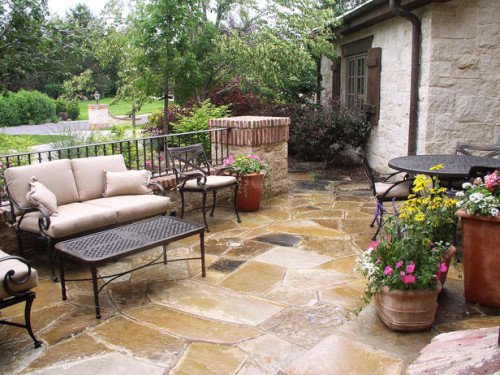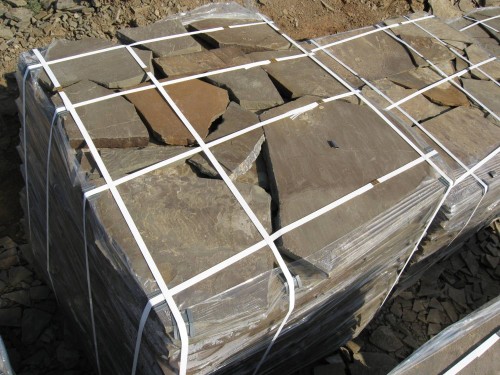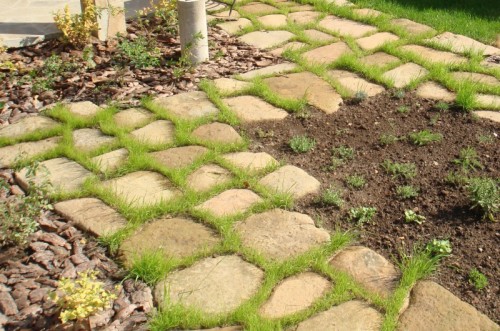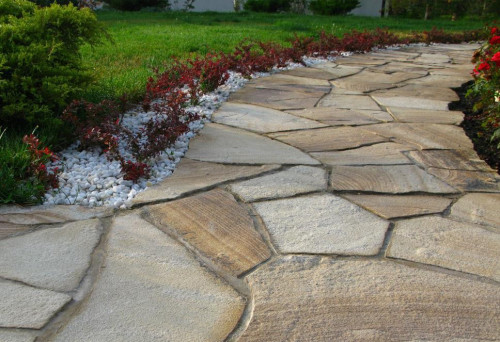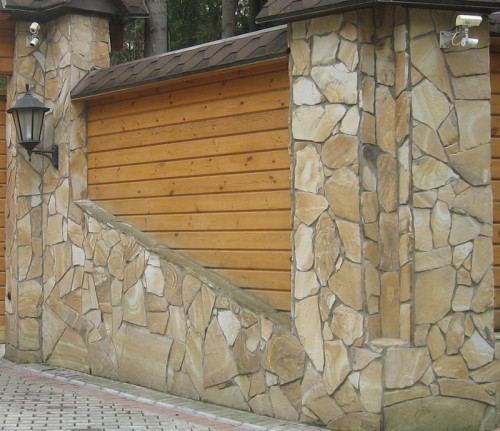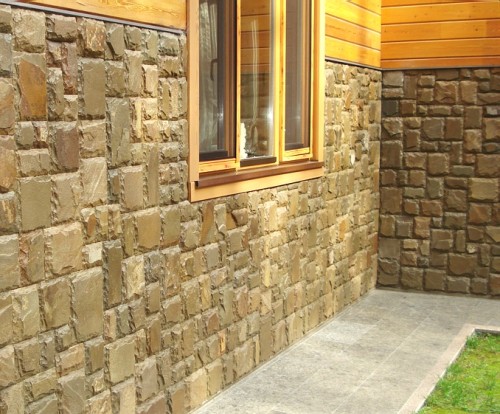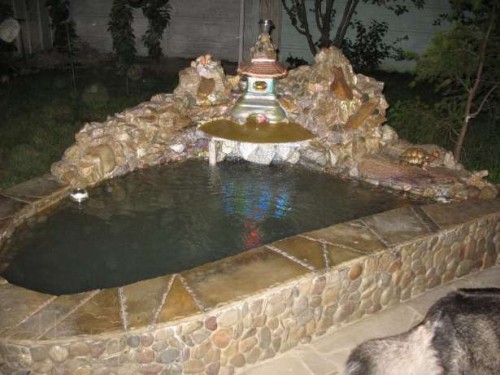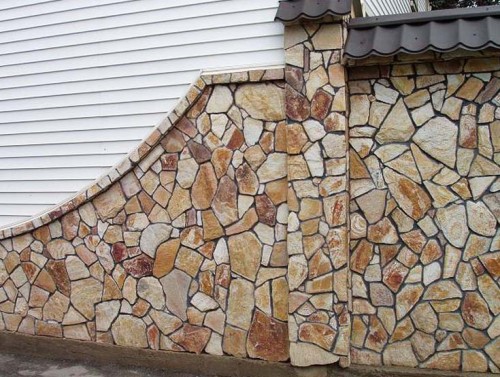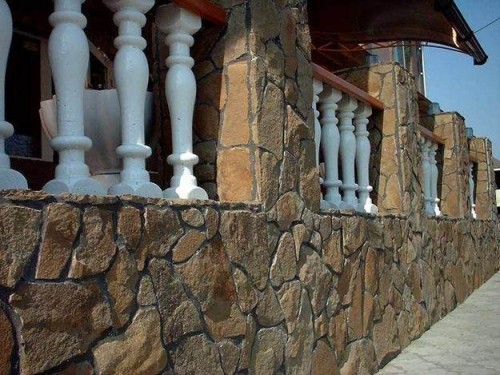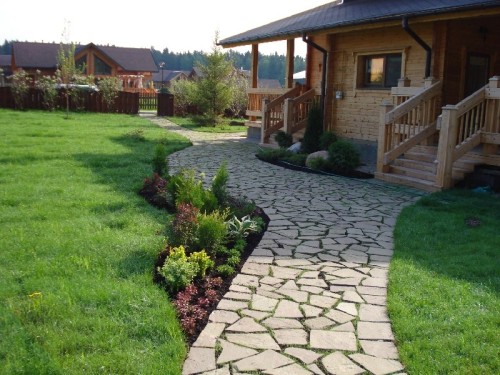Natural stone sandstone is widely in demand in construction for lining a variety of horizontal and vertical surfaces. Thanks to natural origin, excellent decorative properties and affordable, sandstone is used as a facing material for the finishing of facades of buildings, internal interiors, as well as for paving tracks. In order for the operation of this wall and facing material to be as long as possible, when working with it, the features of the laying technology should be taken into account.
Content
Sandstone use
There are several types of sandstone, including the shell and limestone. The composition of this natural stone can include a significant amount of quartz, field spat, as well as mica and chlorite minerals. Depending on the natural conditions of formation, the sandstone stone may differ layered, air and porous or smooth structure. After special processing for construction, this stone is successfully used with broken, ribbon, stuffs and sawn edges.
Due to the diverse color scheme of monochromatic or flowing in each other with shades of white, gray, beige, yellow, red-brown (sometimes the shades of blue and green) are also encountered) this facing material provides ample opportunities for designing various outer and internal surfaces. Oblased with a special heat treatment (the so-called "fried") gray-green sandstone receives additional properties of strength and ceramic hardening - such a stone red-brown looks luxuriously and is characterized by a higher cost. Using the facing material of various colors and shades, you can achieve impressive decoration effects.
The history of sandstone in construction as a wall and facing material includes several millennia - the ancient fortresses, castles and social facilities were traditionally built from it. Many modern and well-known municipal buildings are constructed precisely from sandstone. Thanks to the characteristic properties of sandstone (environmental purity, strength and durability), it can be called an elite construction stone. Using it with external work, you can give an exquisite and very decorative view of the grounds and facades of buildings, as well as posts, staircases and fences. With the lining of sandstone of the inner walls, ornamental borders, stairs and fireplaces can be given the interior of the premises a unique atmosphere. With the help of various types of sidewalk sandstone, you can shift pedestrian and access tracks.
This material is convenient in laying, rather durable and characterized by considerable strength - sandstone pavetling with a thickness of the plates from 30 mm can withstand the pressure of the truck. In addition, the sandstone for the tracks is characterized by a rough surface, which makes it possible for emergency braking of the car even in rainy weather. With the help of decorative sandstone, a particularly defined or untreated form can be putting a patio, various platforms, create a unique design of the local area or garden plot - to separate the mini-pond, fountain or pool.
Sandstone laying technology do it yourself
Sandstone laying can be made in several ways. From the variety of masonry, which can be vertical for walls or horizontal for paving tracks and sites, the applied work technology and the composition of the solution will depend. After reading the information as putting the sandstone, and adhering to the specified technology for this type of work, you can perform the stacking yourself.
Sandstone masonry features
In modern conditions, sandstone facing is very popular. It should be noted that with insufficiently careful observance of the laying technology, sandstone can simply fall off. This stone in the construction process slightly absorbs moisture (up to 5-15% of the total), the rest of it is absorbed into the facing surfaces. In the presence of significant temperature drops and humidity, there is no high-quality cladding that can behave capriciously and peel into the solution. To protect yourself from possible problems, in the process of laying sandstone with their own hands it is necessary to use such a solution that will be securely and firmly fix this natural stone.
Put this stone with the help of a specially selected adhesive composition on a variety of basic surfaces - for this it is suitable for concrete, brick, as well as drywall. On the surface of the wood, sandstone will not hold on, as this stone and wood have different expansion coefficients - and when the temperatures of the plates of the facing will be departed from the base surface.
The stone "savage" looks great in cladding with contrasting seams of dark color - for this, a special pigment for concrete is added to the solution or apply a special grout. To underline the peculiar texture of the stone and protect against adverse atmospheric influences, the surface can be lacquered. For horizontal surfaces, sandstone plates are placed on a prepared base of concrete with a reinforcement grid either on a tinted cement-sandy solution, while the location of the stones can be adjusted using a pile. For the packing of various sites, garden and access roads, the sandstone laying is recommended for a cement solution, while complex preliminary surface preparation, as when laying a granite or marble, will not be required.
Preparation of facing material
Pre-sandstone must be rinsed from dust and dirt for better adhesion with the base surface.
The stone that has not been thermal processing is also required to be pre-grilled - in this way it will be possible to get rid of the surplus salt, which can be bought on the finished masonry. Then you need to clean the stone using a metal or plastic brush to remove fragments of dirt and moss from its surface. After washing, decompose sandstone on a clean film, picking up suitable shape transitions and shades to evaluate how the track or wall will look like.
How to make sandstone tracks do it yourself
In order for water to be on the site or pedestrian walkway, it is necessary to plan work in such a way that the paved surface creates a small bias from the house. If there is no slope on the base surface, it will be necessary to create, adjusting the base from the building solution to the level before laying the stone. To create garden tracks and terraces use a variety of sandstone called Planics. Despite the fact that this stone has high strength and significantly stronger ceramics, it is quite convenient in processing - it is easy to produce it with a cutting with a grinder.
For quick installation of pedestrian garden tracks, it will be necessary to do a simple sequence of actions - respectively, the width of the track is removed by a 15-20 cm thick layer in the processed zone, put the layer of sand and rubble in its place, and then be sandstone from above. If you want to make a more durable and durable coating of a flair, which can serve decades, withsting significant loads, it will be necessary to thoroughly prepare the base surface.
When performing data, these tools and materials may be needed:
- roulette;
- building level;
- pegs and rope;
- reinforcement grid in a step of up to 100 mm;
- master OK;
- bulgarian;
- putty knife;
- cement;
- solution tank;
- glue for tile (for example, "Cerezite 85" or "Tokan");
- drill and special nozzle-mixer;
- shovel;
- rubber cizyanka;
- washed river sand;
- crushed stone (with a fraction of 25-40 mm).
In addition, to create a durable coating, the sandstone is needed with a stove thickness of at least 30 mm.
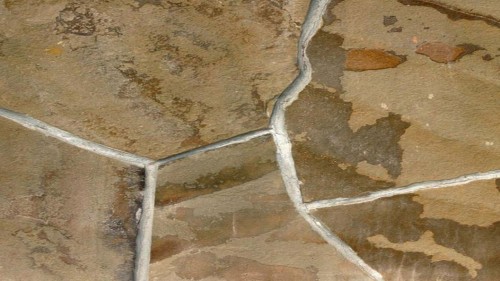
Stages of work:
- At first, it will be necessary to make marking of the territory being processed - for this you use pegs, driven into the ground, with a rope stretched between them at the height of the future end surface.
- Remove the strain layer with a thickness of 25-30 cm. Purple into the resulting trench of the sand layer with a thickness of about 5 cm, thoroughly confuse. Cover it with a layer of rubble - so that through it does not transluce the sand, and again wipe. Put the reinforcing grid on top.
- Next, it will be necessary to prepare a solution - for this it is necessary to mix cement and sand in the proportion one to three.
- Then it is necessary to pour the processed zone with a cooked solution with a layer of 5-8 cm and leave for further frost for two days. To avoid drying and cracking, in sunny weather it is recommended to cover the concrete tie film.
- After the specified time, you can proceed directly to sandstone laying. To do this, a small amount of adhesive will be added to the usual cement-sandy solution (1: 4) (at the rate of 1 part of the adhesive mixture on 10 parts of the solution).
- Spread the material on the track in the desired sequence, picking up the face. Large stones with relatively smooth stones are recommended to lay out along the edges of the track, filling the middle smaller.
- Stacking sandstone is recommended to start from the edges, gradually moving towards the middle. Rimming the tiles one by one, lay the layer of the solution under them and press them for gluing, tapping in China.
- After that, it is necessary to cut the surplus of the solution and use the grout for the seams.
The sandstone tracks laid out by their own hands will decorate your site, besides they will look original and unique.
Facing the walls of sandstone
Sometimes the facade of the building is completely laid down by sandstone, more often they are facing the base of the house, having separate decorative elements above the surface of the walls.
To perform sandstone laying onto the walls yourself, you will need to do the following sequence of work:
- first you need to prepare the surface under the laying of sandstone. To do this, you will need to clean them from garbage and peeling plaster. The loose stucco can be strengthened by applying deep penetration into it, so that it is deeply absorbed into the wall. The final surface must be smooth and solid;
- so that the stacked sandstone kept tightly on the wall, it will be pre-console to fasten the plastering mesh on a fast-mounting dowel with washers;
- next, you will need to make splashing on the wall - for this, it is not too liquid cement-sandy solution in proportion 1: 3. This mixture is pulled by a thin layer on the wall, so as to cover various irregularities, as well as the seams of wall masonry and create the basis for further sandstone laying;
- adhesive solution must be prepared as follows - two parts of the glue type "Cerezite 117" or "Tokan" add to one part of the cement and one piece of mock river sand. Some wizards use a solution for vertical sandstone masonry at all without cement content. In any case, for high-quality consolidation of this stone on the wall, it is necessary that glue prevailed in the solution, and not a sand-cement mixture. With all this, it is not recommended exclusively to use, otherwise the masonry will not be able to "breathe" later, it will take salt on the surface of the stone with time, to damage and burst;
- after a few hours, when the layer of solution on the wall serves, you can start styling the stone - for this you need to apply a prepared adhesive solution to the surface of the wall and to dissolve it with a toothed spatula;
- next, you will need to consistently apply sandstone to the wall and put into the solution, so that there are no air "pockets". If you get to the outer surface, the solution stone should immediately consider it with a wet sponge, otherwise it will be very difficult to get rid of it after drying;
- after performing these works, waiting for the adhesion of the adhesive mixture, it is necessary to use the grout for the seams (natural or contrasting dark shade). The surface lined in this way can also be lacquered.
In compliance with the methods of working with this material, the walls and paths from sandstone will rely for a long time with their respectable and unique species.



